Natural Area Preservation News
Protecting and restoring Ann Arbor's natural areas and fostering an environmental ethic among its citizens.
Volume 21, Number 2
Summer 2016
Park Focus
Earhart, Earhart West, Glazier Hill, and Glacier Highlands
Katie Carlisle, Park Steward Coordinator
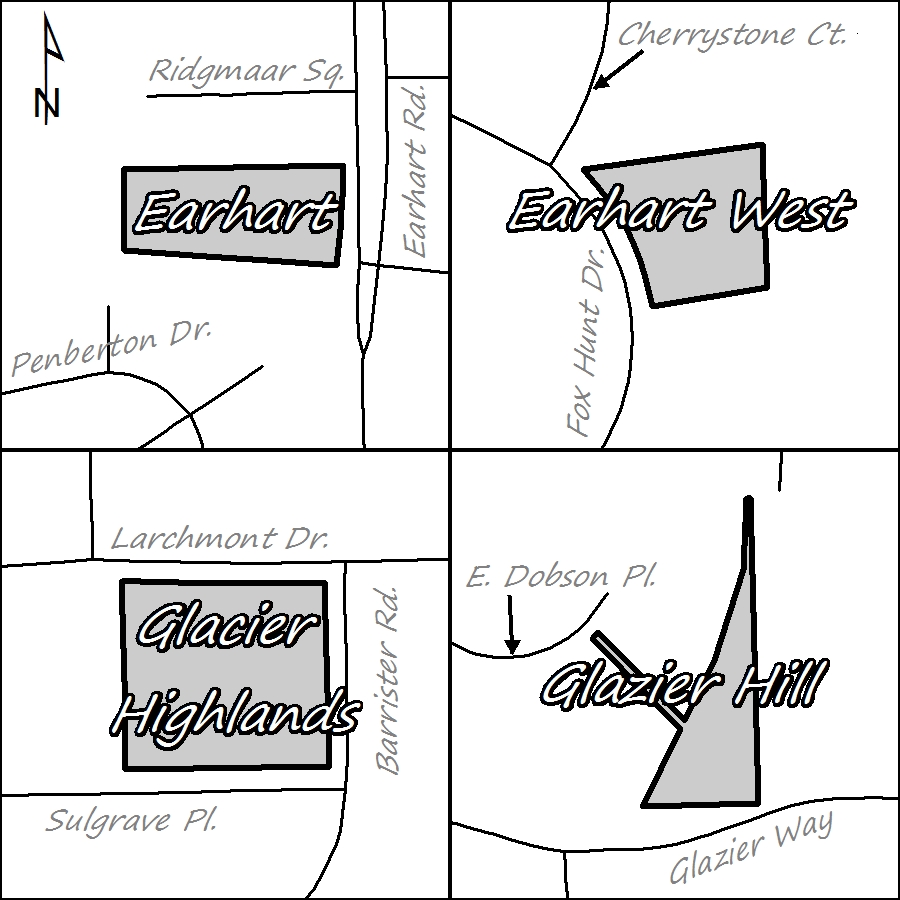
You may know one or two of Ann Arbor’s natural areas, or maybe ten or more, but did you know there are over 80 of them? Our natural areas range in size from over 150 acres to as small as an acre or less. A Park Steward recently told me that he lived a couple of blocks away from his neighborhood park for ten years before exploring it.
My challenge to you is to find a new park or natural area, and take some time to get to know it. It might not be as large as some parks, and all are in different stages of restoration, but I’m sure you’ll find something to appreciate. I did just that recently while exploring some small neighborhood natural areas around Ann Arbor: Earhart, Earhart
West, Glazier Hill, and Glacier Highlands.
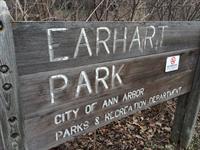
Earhart Park
Earhart is located on the west side of Earhart Road between Geddes Road
and Glazier Way. It is approachable by foot (no parking) and recognizable by a sign on the East side of the natural area. At first, one will notice that there are no paths going into the nature area. When Earhart was first acquired by the Parks Recreation before 1980, there was a wood-chipped trail that left from Martin Luther King Jr. Elementary School and made a loop around the pond. This trail, including its lookout points, and the rest of the property, was used by the school for field trips.
Nowadays, this path is no longer evident. This didn’t stop me from exploring, however. It was a nice change to choose where I wanted to traverse, instead of following a predetermined route. This set the tone for my walks throughout the day by encouraging me to be more observant of what lay ahead.
Speaking of observations, I could hear many birds enjoying the day. The wind was blowing and the trees were swaying. A population of frogs live in the pond and surrounding marsh within the park. Of all the natural areas I visited, Earhart was highest on the scale of habitat quality and plant composition. In the spring, one might find rue anemone blooming here, a native perennial wildflower with small white to pale pink flowers. The park also contains a swamp white oak, an uncommon tree that has become rarer in this region with the disappearance of wetlands.
Earhart West Park
Earhart West is the smallest of the featured parks at 0.9 acres. It is nestled
in a lovely neighborhood between a few houses on Fox Hunt Drive, off of
Green Road. It’s very appealing from the sidewalk with a grassy area that
includes a picnic table for a nice sunny afternoon lunch. There is a small
stream running through the natural area which provides a source of water
to animals. It is a good mix of shrubs, trees, and wildflowers but the
diversity of plants is low, and almost half of the species are invasive. Still,
it gives the neighborhood and passersby some contact with nature.
Glazier Hill Park
Glazier Hill may be the least visited of these natural areas. The entrance
is somewhat hidden between two houses just before the cul-de-sac on
Dobson. It doesn’t get many human visitors, but deer have made the
park their own. I spotted at least four of them when I walked in to their
resting place. There are no obvious human paths in Glazier Hill, but there are many game trails weaving through the honeysuckle. Over a hundred different native plant species have been found in Glazier Hill, including the fragile fern (Cystopteris fragilis), which is found in only a few sites within Ann Arbor.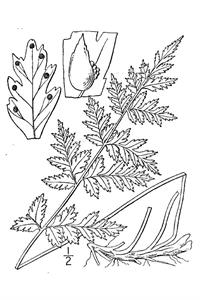
Glacier Highlands Park
Glacier Highlands is unique in the sense that it’s mostly a developed park with a section of natural area in the center. It’s a great balance of open space, developed land, and natural area in the middle of a lovely neighborhood. I picked a spot in the open field to observe my surroundings while kids played basketball on the court and a mom and daughter played on the park’s playground. Glacier Highlands is home to the huge oak trees, characteristic of the city of Ann Arbor. On a hot summer day, I can imagine the open spaces full of neighbors having a nice picnic or playing Frisbee while others play volleyball, grill at the picnic table, or shoot hoops.
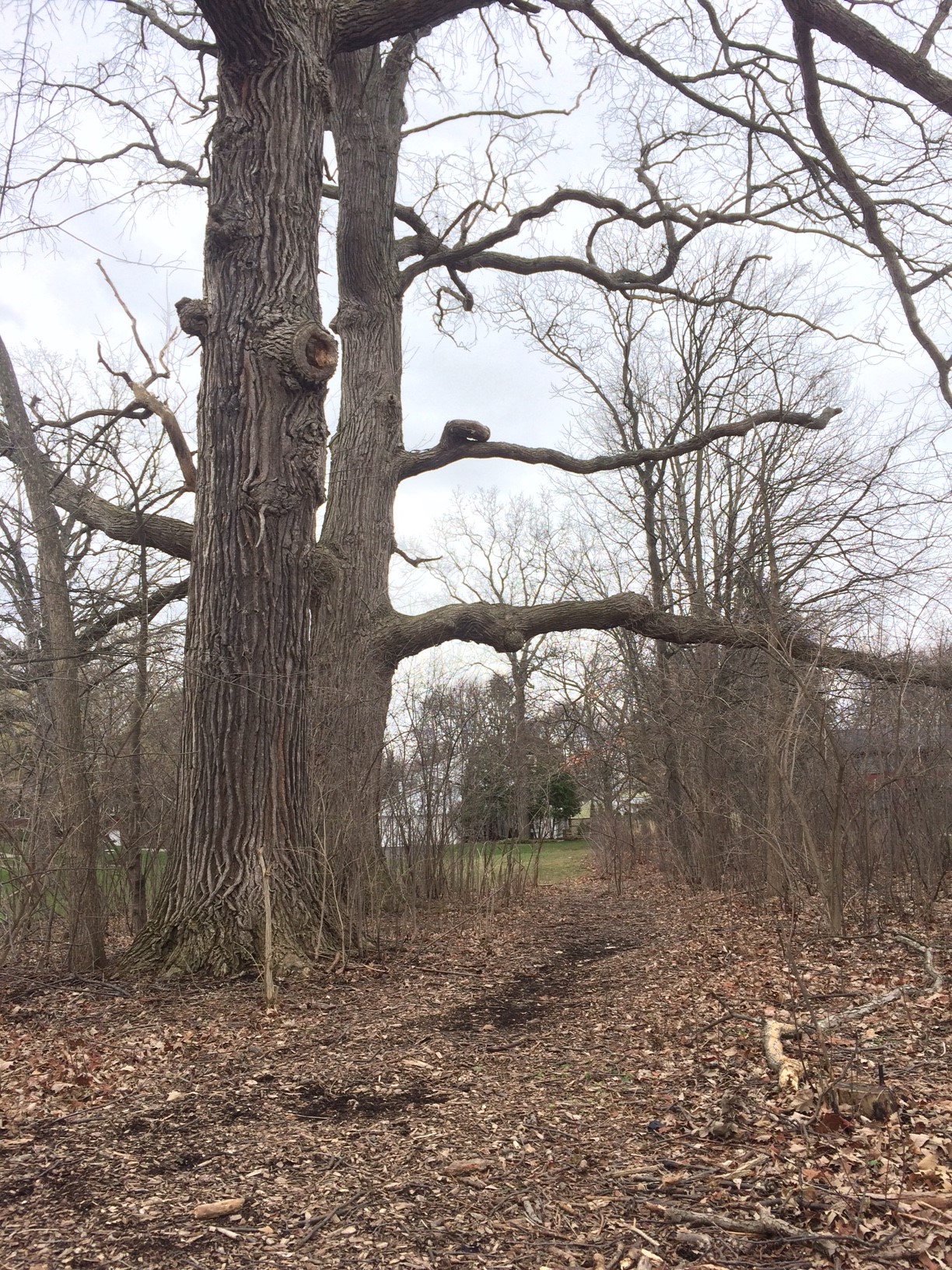
These are a few examples of natural areas found within Ann Arbor’s neighborhoods. I can imagine that they provide wonderful natural playgrounds for kids and families to explore birds in trees, plants in wetlands, or bugs under logs. I hope you will be inspired to get outside and explore the nature retreat in your own neighborhood.
Coordinator's Corner
Time to Learn Some New Songs
David Borneman, Deputy Manager for Volunteerism and NAP
I started playing the guitar in college, many years ago. I even took lessons for a year, which gave me much greater focus than me just banging out chords on my own. In that time, I learned a few good songs that I really loved to play. But then my interests changed, as they do when you’re in college. I’d set my guitar aside for a few days, or weeks, or months. When I did finally pick it up again, I’d have to start from scratch, re-building the calluses on my fingers, re-learning those same songs I once knew. Unfortunately, that’s been my pattern with the guitar ever since college. I’d sometimes go for years without touching it. Then I’d pick it up and re-learn those same old songs again. But I’ve been better about that the past five years. I’ve actually stuck with it, and I’ve been able to finally learn those old songs pretty well. The only problem is that they’re the same old songs I’ve been playing for the past three decades! And even though they’re still great songs, I think it is time for a change, for something new. So now I’m learning new songs. Stretching myself. Growing. Trying something new. Getting out of my rut. And it feels good! I’m finding a new love for the guitar that I haven’t felt for many years.
How about you? Are you ready for a change? Maybe you’ve been visiting the same parks for many years, going to the same workdays, doing the same activities. Oh, those are still fine parks to visit and activities to do. But maybe it’s time for a change, or at least an addition to that routine. Maybe it’s time to venture out to a different one of Ann Arbor’s 158 city parks and help at a workday there. Or maybe it’s time to try something completely new and get involved in one of our wildlife inventories. Help with the breeding bird survey, or come to our first ever BioBlitz at the Leslie Science and Nature Center/Black Pond Woods. Or maybe it’s time to step up and take on the responsibilities of being a Park Steward in your favorite natural area. Whatever your interest, this is your invitation – and nudge – to take a chance and try something new at NAP!
I bet you’ll be happy if you do. It’s too easy to stick with the familiar, the tried and true, the comfortable. The same path through the same woods, at the same time of day. Although there’s something therapeutic about that ritual, with definite benefits, there are also benefits of reawakening your senses, taking in different sights and sounds that are outside of our usual routine. Sometimes we have greater appreciation for natural beauty at a new park than at our usual destinations.
So how about it, ready for a change? Ready to learn some new songs? Check out the NAP calendar at A2gov.org/NAPevents for some new opportunities. If nothing there grabs you, contact the office at 734.794.6627 to discuss other ways we can help you stretch and grow!
Modern Day Treasure Hunting In Our Natural Areas
Becky Gajewski, Stewardship Specialist
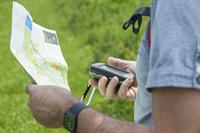 Have you ever wanted to go on a treasure hunt? You don’t have to venture off to an exotic beach or a dangerous jungle – you can experience the fun of a treasure hunt right in your neighborhood park or natural area! All you need to play is an internet connection and a GPS or smartphone, and you can join in the global game of geocaching.
Have you ever wanted to go on a treasure hunt? You don’t have to venture off to an exotic beach or a dangerous jungle – you can experience the fun of a treasure hunt right in your neighborhood park or natural area! All you need to play is an internet connection and a GPS or smartphone, and you can join in the global game of geocaching.
Geocaching (Jee-oh-CASH-ing) is a treasure-hunting game that is played using a handheld GPS receiver or a geocaching app. Participants try to find “caches,” containers filled with prizes or tradable items, which are hidden on public lands. Coordinates to the caches and hints for where to find them are posted online at www.geocaching.com. All you need to do is put those coordinates into your GPS, and you’re ready to start the hunt!
Caches are hidden in many different ways and in a variety of different containers. Some are hidden on the ground under logs and branches, while others are hung in trees. The containers range in size from large ammunition boxes and plastic jugs to tiny magnetic capsules that may be disguised to look like something innocent, like a nut and bolt. As a general rule, caches are not buried. All caches are rated on the geocaching website according to how difficult they are to locate. More difficult caches may be in hard-to-find containers, or may require you to travel over rough terrain to find them.
Once you discover a geocache, open it up to see what’s inside! All geocaches will contain a logbook for you to sign, and the larger caches often contain small items that you can take as a prize. If you take something from a geocache, however, you must replace it with another item. Some caches will contain special items called travel bugs or geocoins, and these are not meant to be kept. Each travel bug or geocoin has a special tracking number on it, giving them the nickname of “trackables.” The tracking number is logged into the geocaching website, where you can see where the trackable has been. Some trackables have traveled thousands of miles! If you find a trackable, you can take it to another geocache to help it along its journey.
You can also get involved with geocaching by hiding a cache yourself. If you would like to hide a geocache in one of Ann Arbor’s parks, please visit NAP’s website and fill out an application for a geocaching permit. We will review the cache location you propose in order to make sure it is not within a sensitive habitat that could be damaged by repeated foot traffic. We will also make sure it’s not within one of our prescribed burn units, where the container could be damaged by fire.
Geocaching has grown into a worldwide phenomenon since the first ache was hidden in May of 2000. Today, there are over 2.8 million geocaches hidden around the world, and 15 million geocachers. There are over 300 geocaches hidden just within 5 miles of Ann Arbor! If you decide to give geocaching a try, please be mindful of our natural areas as you do so. Don’t leave any trash behind, and try not to trample the vegetation. Above all, enjoy yourself while you are on your treasure hunt! Take pictures of the things you discover in our parks, and feel free to share them with us. You may find that the game of geocaching offers many rewards besides the ones hidden in the containers.
NAPpenings
THANK YOU!
Many thanks to the groups who volunteered with NAP recently. We could not make such a difference without you: UM Delta Sigma Phi, Temple Beth Emeth, EMU GREEN Club, EMU Greek Life, Greenhills Schools, Ann Arbor MSU Spartan Alumni Association, SBD North American, Fresh Start Clubhouse, St. Pauls Lutheran Church, Community High School, Huron High School, Canton Prepatory High School, King Elementary School, Cub Scout pack 131 and U of M Circle K Environment Committee.
WELCOME, NEW PARK STEWARDS!
Mark Lee - Hollywood Park
Staff Updates
Updates...

MIKE HAHN - STEWARDSHIP SPECIALIST
Life takes unexpected twists and turns sometimes. This past February, Mike was in a serious sledding accident that resulted in nerve and ligament damage. Considering the severity of his accident, he is lucky not to have suffered any broken bones or permanent injuries. His healing process is expected to take the better part of a year and may involve multiple surgeries, but fortunately he will be able to walk again. While his body is healing, you won’t see him out in the field as much, but he will still remain in his role as Stewardship Specialist, managing many of the behind the scenes tasks at NAP. We invite you to send your well wishes to [email protected].
Welcome...

ERIN TODD - FIELD CREW
I recently graduated from the University of Michigan with a B.S. in Environmental Science and a minor in Plant Biology. I look forward to gaining hands-on experience, supporting diverse and resilient natural areas in the city I’ve called home for almost 4 years. Before joining the crew, I worked as an intern for Matthaei Botanical Gardens & Nichols Arboretum and led many volunteer workdays. I am excited to continue meeting more enthusiastic and dedicated Ann Arbor community members and NAP’s amazing volunteer base!
 JULIET BERGER - ORNITHOLOGIST
JULIET BERGER - ORNITHOLOGIST
I’m a lifelong birder, so I am thrilled to join the NAP staff as the new Ornithologist. With my backgrounds in both social work and science, I operate at the nexus of birding, bird science, and community organization. I have been President of Washtenaw Audubon Society for two years, and I love to lead bird walks and answer bird-related questions. I am a coach for Feathered Friends, a Washtenaw Elementary Science Olympiad event about birds, and I am a longtime NAP Breeding Bird Survey volunteer. I am excited to work with all the amazing NAP volunteers and staff.
 KATIE CARLISLE - PARK STEWARD COORDINATOR
KATIE CARLISLE - PARK STEWARD COORDINATOR
With a strong passion for the natural world and a diverse science background, I’m excited to be working with NAP as your new Park Steward Coordinator. I recently relocated back to Michigan from the Pacific Northwest where I was working as an outdoor environmental educator near Seattle and attended school at Boise State University. I am eager to work alongside all the dedicated volunteers and stewards in Ann Arbor’s natural areas.
 SAMANTHA “SAM” DAVIS - FIELD CREW
SAMANTHA “SAM” DAVIS - FIELD CREW
I recently graduated from U of M with a B.S. in Ecology and Evolutionary Biology. Previously, I worked for the Grand Traverse Conservation District and the Matthaei Botanical Gardens. I love being outdoors and working to restore our natural ecosystems. I look forward to becoming even more involved in ecological restoration by joining the conservation crew here at NAP. I am very excited to work with all the other great staff and volunteers that keep our parks enjoyable for everyone!
Would you like to be part of the NAP Staff team? Follow the city jobs website (a2gov.org/jobs). Positions can open throughout the year. NAP also has unpaid internships that provide valuable experience! For internship information contact NAP directly: NAP@a2gov. org or 734.794.6627.
NAP’s Apps of Interest
George Hammond, Inventory and
Outreach Assistant
Since 1990, 235 species of birds have been
observed in Ann Arbor’s parks! Here are a
couple of great tools that can help you
identify birds you see, record what you
saw, and share it with NAP and the world.
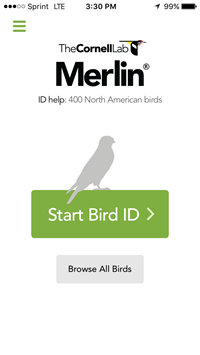 The Merlin app poses a few questions
about where you are and what you are
seeing or hearing, and presents a list of
common bird species that match your
description. The app includes photos,
information and songs for each species.
http://merlin.allaboutbirds.org/
The Merlin app poses a few questions
about where you are and what you are
seeing or hearing, and presents a list of
common bird species that match your
description. The app includes photos,
information and songs for each species.
http://merlin.allaboutbirds.org/
eBird Mobile lets you store and share your
observations using the amazing eBird
database. The eBird app and website are
also great tools for learning where to find
different bird species, wherever you are. http://help.ebird.org/customer/en/portal/articles/1848031-ebird-mobileapps-overview
Birding is a great way to get outside and
enjoy our parks and natural areas, and
these apps will help you have more fun in
this pursuit.
Upcoming Events
Don't forget to check our out upcoming workdays and events at a2gov.org/NAPevents!
